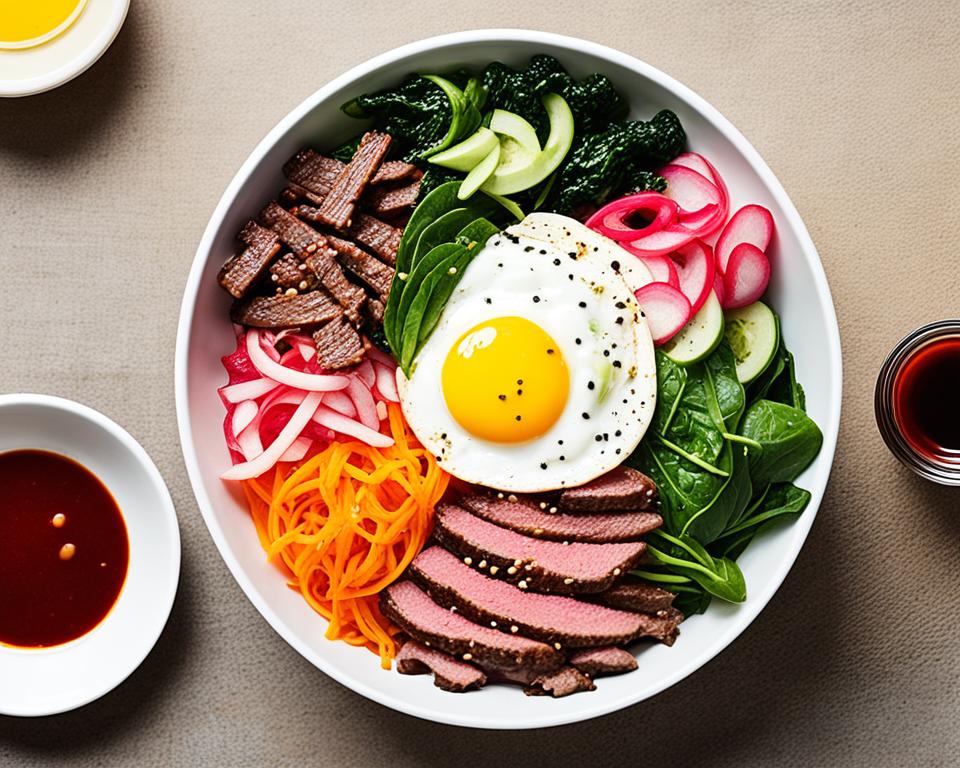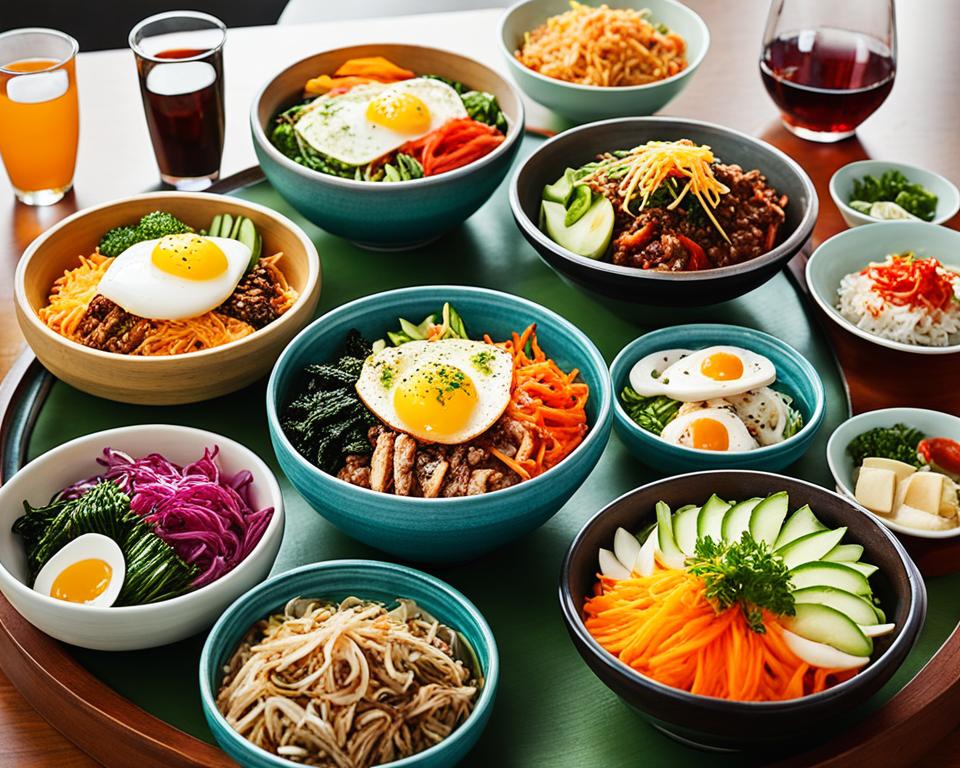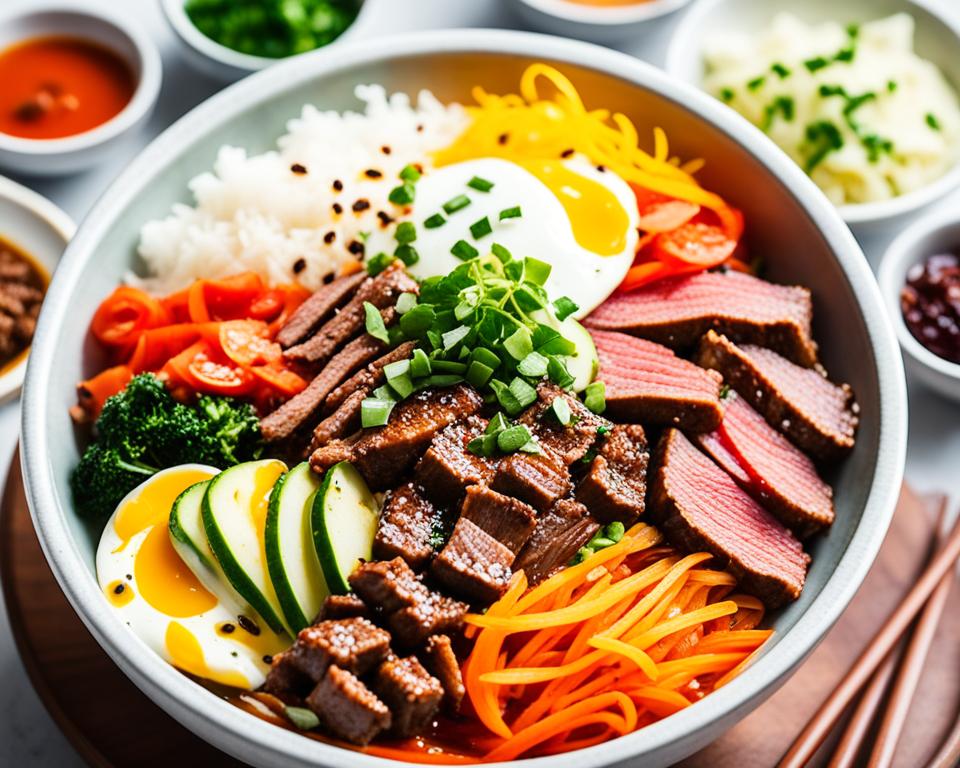Bibimbab, also known as bibimbap, is a beloved Korean dish. It’s popular all over the world. This dish includes sautéed vegetables, savory beef, a cooked fried egg, and a stone bowl (dolsot). It’s the heart of Korean cuisine. We’ll show you how to make this classic dish. You’ll capture its bright flavors and textures at home.
Read interesting things at : legend-of-raphael
Key Takeaways
- Bibimbab is a traditional Korean dish that combines rice, sautéed vegetables, beef bulgogi, and a fried egg.
- The dish is typically served in a heated dolsot (Korean stone bowl) to maintain the sizzling temperature.
- Gochujang, a fermented Korean chili paste, is the key condiment that brings the dish to life.
- Customizing the dish with different vegetable toppings and protein options allows for personalization.
- Bibimbab is not only delicious but also highly nutritious, making it a balanced and healthy meal choice.
What is Bibimbab?
Bibimbab is a popular Korean dish known for its mix of flavors and textures. Its name means “mixed rice.” This captures the essence of the meal – a bowl of warm rice with sautéed veggies, spicy gochujang sauce, a fried egg, and sometimes beef.
Definition and Origin
Bibimbab comes from the Joseon dynasty in Korea. At first, it was a simple meal for peasants, using leftover rice and veggies. It has since grown into a beloved Korean dish, adding more ingredients over time.
Cultural Significance
This dish is hugely important in Korean culture. It’s more than food; it symbolizes Korea’s culinary tradition. People often eat it during cultural events, showing pride in their heritage and cooking skills.
Ingredients for Authentic Bibimbab
For a true Bibimbab, you need top-notch ingredients. They all work together to make each bite special. Imagine the fluffy rice topped with beef bulgogi and colorful veggies. These elements are key in getting the real taste of this Korean favorite.
Rice
At the dish’s core is short-grain white rice, like Korean or Japanese kinds. This rice is key because it sticks well. It ties the meat, veggies, and flavors beautifully.
Beef Bulgogi
Beef bulgogi is vital, usually made from thinly sliced beef. It gets soaked in a mix of soy sauce, sugar, garlic, and more. This not only makes the meat tender but gives it the sweet-savory kick of Korean food.
Sautéed Vegetables
Next, we have a rainbow of sautéed veggies, each adding its own layer to the dish. These often include spinach, bean sprouts, and lettuce, plus some crunchier options. Think carrots, zucchinis, and mushrooms for variety.
Gochujang Sauce
Gochujang is what makes Bibimbab sing. It’s a fermented chili paste and oh so essential. This sauce brims with spicy, sweet, and umami notes. It ties everything together deliciously.
Preparing the Dolsot Bowl
The traditional way to serve Bibimbab is in a dolsot. It’s a Korean stone pot that holds heat really well. This bowl isn’t just for looks. It keeps the food warm and sizzling while you eat.
The dolsot bowl is key to how bibimbap is served. Its stone material heats up and stays hot. This ensures the bibimbap is steaming from start to finish. It makes a meal with sound of sizzle and sights of steam at the table.
First, the dolsot bowl needs to get really hot. This is done by heating the empty bowl a lot over a flame or a dolsot cooktop. Then, when the meal is put in, it makes a crispy and sweet layer at the bottom.
Serving Bibimbap in a heated Korean stone pot is about more than looks. It keeps the food’s perfect taste and texture. Each bite will be just as delicious and enjoyable as the one before.
Cooking the Rice
The type of rice and how you prepare it really matter for Bibimbab. Using short-grain white rice is best. It’s stickier and absorbs flavors well. This makes the rice hold the dish together better.
Rice Variety
Korean short grain rice works great for bibimbap rice cooking. It’s a bit plump, sticky, and absorbs sauces and oils well. This creates a tasty and solid foundation for the dish.
Cooking Techniques
For perfect rice preparation for Bibimbab, stick to Korean methods. First, rinse the rice well to get rid of extra starch. Then, use a 1 cup rice to 1 1/4 cups water ratio. Cook the rice on the stove or in a rice cooker until it’s soft and airy. After, let it rest a bit, then fluff it with a fork.
Marinating and Cooking Beef Bulgogi
The beef bulgogi is a key part of Korean cuisine, especially in Bibimbab. To make it, you’ll first marinate the beef. This gives it the delicious sweet and savory taste that Korean food is known for.
Bulgogi Marinade
The secret to great beef bulgogi is in its marinade. It’s made of soy sauce, brown sugar, garlic, and ginger. There’s also a bit of sesame oil. The soy sauce makes the meat tender. Brown sugar gives it a little sweet touch. Garlic and ginger add a lot of flavor. And sesame oil brings in a hint of nuttiness.
Cooking Methods
After marinating, it’s time to cook the beef bulgogi. The usual way is to grill or pan-sear it on high heat. This quick cook method caramelizes the meat. It gives it that perfect mix of crunch and flavor.
Sautéing Vegetables
Sautéed vegetables are key in Bibimbab, offering a mix of tastes and textures. You’ll find spinach, bean sprouts, lettuce, and crunchy veggies like carrots and mushrooms. They all come together to make the dish truly special.
Vegetable Medley
To make the Bibimbab shine, pick a mix of fresh, seasonal veggies. Mixing leafy greens with crisp and earthy mushrooms not only looks good but tastes great too. It brings a harmony that’s essential for this dish.
Seasoning and Aromatics
A special Korean seasoning makes these vegetables stand out. It uses soy sauce, sesame oil, garlic, and a bit of sugar. This mix boosts their taste, adding to the dish’s overall yumminess.
| Vegetable | Preparation | Seasoning |
|---|---|---|
| Spinach | Briefly sautéed until wilted | Soy sauce, garlic, sesame oil |
| Bean Sprouts | Blanched and tossed with seasoning | Soy sauce, sesame oil, salt |
| Carrots | Julienned and sautéed until tender-crisp | Soy sauce, brown sugar, sesame oil |
| Zucchini | Sliced and sautéed with a light char | Garlic, ginger, soy sauce |
| Mushrooms | Sliced and sautéed with garlic and soy sauce | Soy sauce, sesame oil, black pepper |
Turning each sautéed vegetable into a top-notch topping is key to crafting the perfect Bibimbab. This method brings out vibrant flavors that marry well with the dish.
Making Gochujang Sauce
Gochujang is a fermented Korean chili paste that makes Bibimbab tasty. This sauce combines spicy, sweet, and umami flavors. It makes the dish taste amazing.
Ingredients
To make an authentic gochujang sauce, gather some key items. You’ll need Korean chili paste, soy sauce, rice vinegar, honey, and garlic. These ingredients make the bibimbap sauce taste amazing.
Consistency and Flavor
Getting the right gochujang sauce mix is crucial. It should be thick but easy to use, not too hot or sweet. Add a little chili paste and tweak the other ingredients. You’ll get a bibimbap sauce that tops your Bibimbab dish just right.
Bibimbab
When making Bibimbab, all its unique parts join together. They make a beautiful and balanced dish. Place a lot of Korean short grain rice in the center of the dolsot bowl. Then, add sautéed vegetables, beef bulgogi, and a fried egg. This makes the meal look colorful and interesting.
Layering Ingredients
First, set the rice in the middle of the dolsot bowl. Next, neatly pile up the sautéed veggies like spinach and bean sprouts around the rice. Then, put the tasty beef bulgogi in its own spot and place the fried egg on top.
Mixing and Serving
Ready to eat? Use your chopsticks to mix everything in the dolsot bowl gently. This lets the flavors blend and the textures mix just right. The hot bowl keeps cooking, making the dish look and taste great. Serve it hot to enjoy the mix of colors, smells, and flavors.

Variations and Customizations
Bibimbab is loved for its many different forms. It can match lots of tastes and local styles. You can enjoy everything from vegetarian bibimbap to unique regional bibimbap styles. This makes Bibimbab from Korea a dish that welcomes everyone.
Vegetarian Bibimbab
If you don’t eat meat, you can still enjoy Bibimbab. Just change the beef for tasty veggies like tofu, mushrooms, or whatever is in season. The delicious gochujang sauce and colorful sautéed vegetables keep the meal tasty and wholesome.
Regional Styles
Bibimbab looks different in every part of Korea. In Jeonju, you’ll find Jeonju bibimbap with its own unique mix, featuring special spinach. It also has a soft-boiled egg and the local favorite gochujang sauce. In Jinju, there’s Jinju bibimbap with its delicious grilled beef. And by the sea in Tongyeong, Tongyeong bibimbap stars fresh seafood.
| Bibimbap Variation | Key Ingredients | Regional Origin |
|---|---|---|
| Jeonju Bibimbap | Sautéed vegetables, soft-boiled egg, gochujang sauce | Jeonju |
| Jinju Bibimbap | Grilled beef, sautéed vegetables, gochujang sauce | Jinju |
| Tongyeong Bibimbap | Sautéed vegetables, seafood, gochujang sauce | Tongyeong |
| Vegetarian Bibimbap | Sautéed vegetables, tofu, gochujang sauce | N/A |
Exploring bibimbap variations lets you dive into Korea’s food tapestry. You can learn about different food cultures across the region.
Health Benefits
Bibimbab is a tasty and healthy dish. It’s packed full with nutrients, making it perfect for anyone wanting to eat well. You get a mix of veggies, beef bulgogi, and rice, creating a satisfying and balanced meal.
Nutritional Value
The health benefits of bibimbap come from its amazing mix of essential nutrients. This Korean favorite is rich in vitamins, minerals, and antioxidants thanks to veggies like spinach, bean sprouts, and mushrooms. The beef bulgogi offers top-notch protein, and the rice gives you energy that lasts.
Balanced Diet
Adding bibimbap to your meals can do a lot for your health. It’s rich in carbs, protein, and good fats, making it a balanced dish. This mix supports keeping a healthy weight, aids digestion, and gives your body what it needs to work its best.
Serving and Presentation
Bibimbab is usually served in a heated dolsot. This is a Korean stone bowl that keeps the food hot. It looks great and makes sure your meal stays tasty.
Traditional Dolsot Bowl
The dolsot bowl is key for Bibimbab. It makes the dish look good and stay hot. The hot stone bowl keeps the food sizzling, making every bite yummy.
Garnishes and Accompaniments
There are many toppings and sides that go with Bibimbab. Some of them are:
- Roasted sesame seeds
- Sliced scallions
- Kimchi (fermented spicy cabbage)
- Gochujang (Korean chili paste)
- Soy sauce
These extras make serving bibimbap look and taste even better. They let you add your favorite flavors to the dish.
Pairing with Beverages
Bibimbap goes great with many Korean drinks. These can be both alcoholic and non-alcoholic. They enhance the dish’s strong tastes and textures.
Korean Alcoholic Drinks
Soju and makgeolli are perfect for those who like alcohol. Soju is a clear spirit while makgeolli is a rice wine. They offer a crisp, sweet taste that goes well with bibimbap’s spice and flavor.
Non-Alcoholic Options
Not into alcohol? Try Korean iced tea or sikhye. They’re both sweet and refreshing. These will cool your mouth between bites of bibimbap, fitting perfectly with its flavors.
No matter what you drink, pick something that goes well with bibimbap’s bold tastes. This will make your meal even more enjoyable and complete.
| Beverage | Description | Pairing with Bibimbap |
|---|---|---|
| Soju | A clear, distilled Korean spirit with a slightly sweet and mild flavor. | The crisp, clean taste of soju balances the savory, spicy elements of bibimbap. |
| Makgeolli | A traditional Korean rice wine with a slightly sweet and effervescent taste. | The subtle sweetness and carbonation of makgeolli complement the bold flavors of bibimbap. |
| Korean Iced Tea | A refreshing, lightly sweetened tea made from a blend of Korean herbs and tea leaves. | The cooling, refreshing nature of Korean iced tea helps cleanse the palate between bites of the flavorful bibimbap. |
| Sikhye | A sweet rice punch with a subtle, natural sweetness and a slightly fizzy texture. | The delicate sweetness of sikhye pairs well with the robust flavors of the bibimbap, creating a harmonious balance. |

Storing and Reheating Leftovers
Bibimbab is a great leftover dish, perfect for planning meals. To keep Bibimbab fresh when you store and reheat it, keep its parts separate. This stops the rice from getting soggy.
For leftover bibimbap, use different airtight containers for the rice, veggies, beef bulgogi, and egg. This keeps the flavors and textures of each part. You can keep it in the fridge for 3-4 days. This ensures your leftover bibimbap stays tasty for later.
For reheating, try a microwave or skillet. If you choose the microwave, warm the parts one by one, starting with the rice. This keeps the rice from going too soft. For the skillet, start with the rice and add the veggies and beef. Then, warm the egg.
If you want the rice less dry, add a bit of water or stock while reheating. After everything’s warm, mixing makes a great, quick meal. Enjoy your reheated bibimbap!
| Storing Bibimbap | Reheating Bibimbap |
|---|---|
|
|
Bibimbab in Korean Culture
Bibimbab is much more than just a tasty meal in Korea. It’s a key part of the country’s food story. All through the year, bibimbap in Korean culture is honored at many events and fairs nation-wide.
Festivals and Celebrations
The Jeonju Bibimbap Festival is a standout among Korean festivals with bibimbap. It happens every year in Jeonju, a city well-known for its delicious bibimbap. At this festival, people can try different kinds of bibimbap, join cooking lessons, and enjoy cultural shows.
Regional Specialties
Various regions in Korea have their special take on bibimbap. Like in Gangwon-do, they make Pyeongchang Bibimbab. It’s got vegetables from the nearby mountains and a sauce made from gochujang. Then in Jeju-do, they add fresh seafood, bringing together the best of both worlds.
Tips and Tricks
To make your homemade Bibimbab taste great, remember these bibimbap cooking tips. Cooking each part alone is key. This keeps their unique flavors and textures.
Cooking Techniques
Cook the veggies quick on high heat to keep them crispy. Make sure the beef bulgogi is nicely caramelized. Always watch the rice, as it being over or undercooked will affect the dish.
Flavor Combinations
Trying new bibimbap flavor combinations can really make your Bibimbab shine. Mix up the veggies like spinach, bean sprouts, carrots, and mushrooms. You can also use different proteins like grilled chicken or tofu.
Follow these bibimbap cooking tips and flavor combos. They’ll help your Bibimbab become more authentic and enjoyable. Don’t be afraid to get creative in the kitchen with this favorite Korean dish.
Conclusion
Bibimbab is a true culinary gem from Korea. It highlights vibrant flavors and a rich cultural heritage. By using this recipe, you can make this dish at home. It will take you to the heart of Korean cuisine.
This guide helps both experienced and new home cooks. It gives you the info and skills you need to make authentic Korean bibimbap. You’ll learn how to choose the best ingredients. And, you’ll know how to cook it right. These steps make sure you can make bibimbap at home and enjoy its amazing taste and feel.
Eating your homemade Bibimbab is more than just good food. It celebrates Korea’s culinary traditions. So, invite your loved ones, cook in a dolsot bowl, and enjoy your Bibimbab. Let its sizzle and scent take you into Korean culture. Here, enjoying bibimbap is all about celebrating its rich and diverse food culture.
